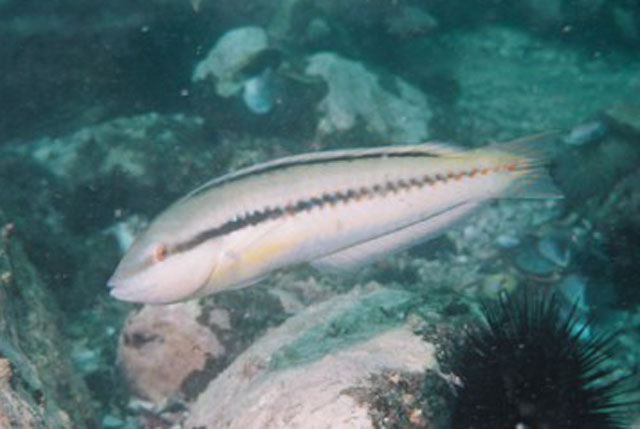| Labridae (Wrasses), subfamily: Corinae |
| 21.4 cm SL (male/unsexed) |
|
pelagic-neritic; marine; depth range 20 - 70 m |
| Southwest Atlantic: Brazil. |
|
Dorsal spines (total): 9-9; Dorsal soft rays (total): 11-11; Anal spines: 3-3; Anal soft rays: 12-12; Vertebrae: 24-24. This specie sis distinguished by the following characters: D IX,11; A III,12; pectoral rays 13; caudal rays 14; lateral line scales 27; body y white with a stripe running on midline of the body from the snout, through the eye to tail; stripe straight, broadest and continuous from the snout to the shoulder, when it turns into a line of close-set spots in a zigzag pattern in alternate scales of 2 adjoining rows; terminal phase have the stripe entirely black or black at the first half becoming brownish, some with golden spots above and below scales, body darkened in the dorsum and the abdomen, becoming grayish or greenish in the area just above the mid-body stripe to the base of the dorsal fin; at the initial phase, the stripe is brown on the first third of its length and yellow to golden on the last two thirds (Ref. 80967). |
| Maximum depth from Ref. 126840. This species was observed foraging solitary on sand bottoms immediately adjacent to the lower end of rocky reefs. Harems that are composed of a few (5-10) individuals are not common but occasionally seen. This fish sometimes venture over the reefs, but generally never shallower than 20 m depth depending on water temperature (they seem to be associated with temperatures lower than 18°C). It also forages mostly on mobile invertebrates on soft and hard substratum, being more commonly observed foraging on sand bottoms and this behavior makes it a potential nuclear species in following associations, as it has been observed in other species of Halichoeres (Ref. 80967). |
|
Not Evaluated (N.E.) Ref. (130435)
|
| harmless |
Source and more info: www.fishbase.org. For personal, classroom, and other internal use only. Not for publication.
